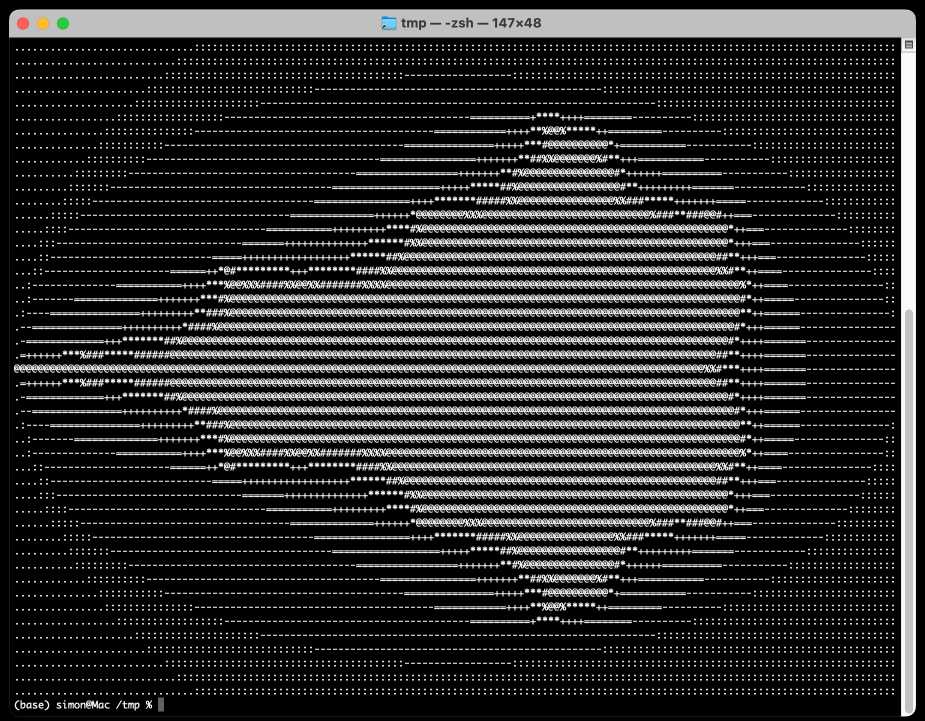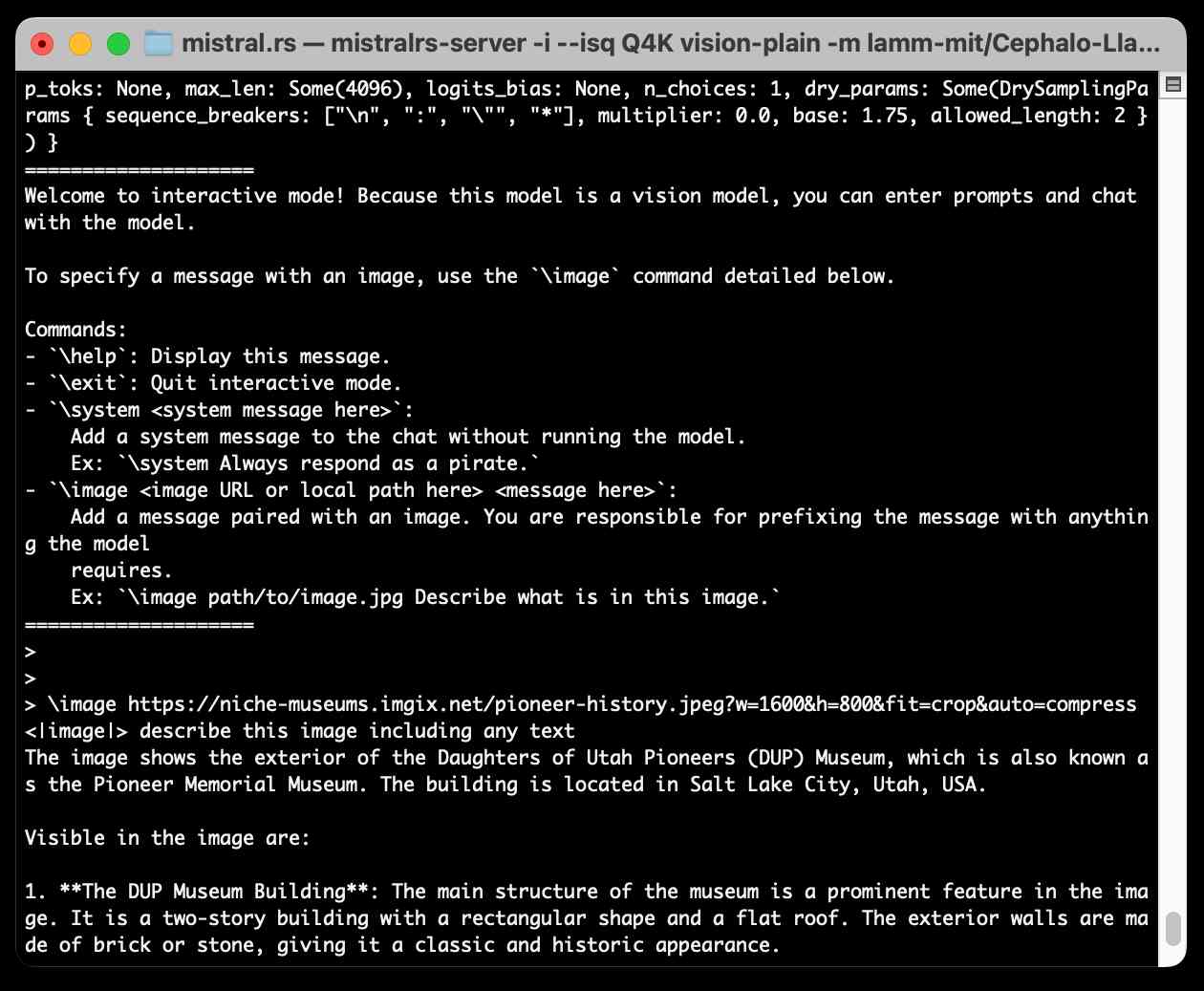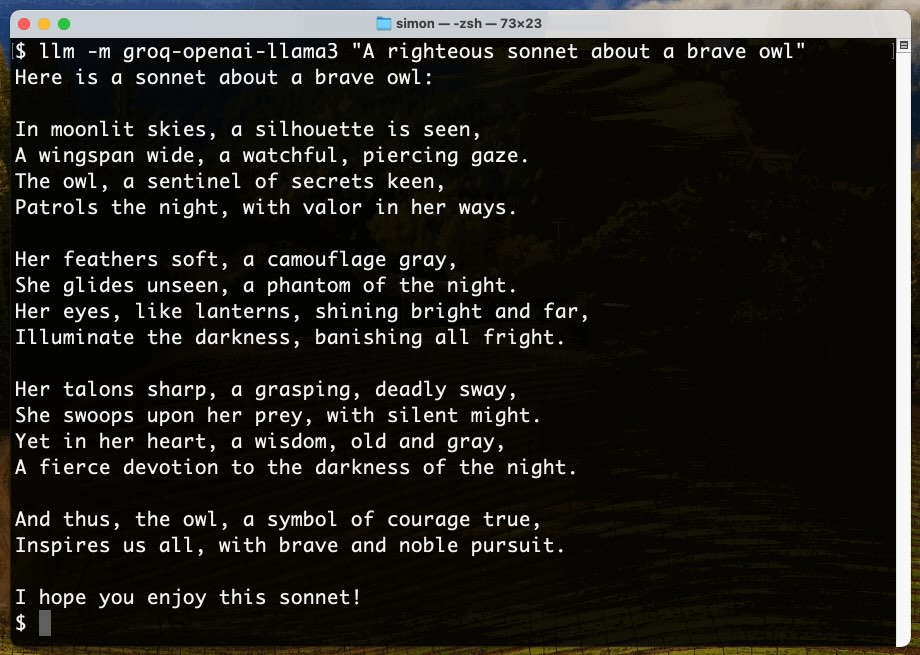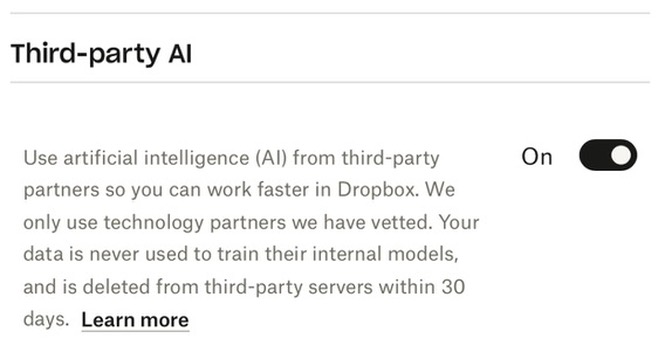68 items tagged “edge-llms”
LLMs that can run on consumer hardware like laptops or mobile phones.
2024
Open WebUI. I tried out this open source (MIT licensed, JavaScript and Python) localhost UI for accessing LLMs today for the first time. It's very nicely done.
I ran it with uvx like this:
uvx --python 3.11 open-webui serve
On first launch it installed a bunch of dependencies and then downloaded 903MB to ~/.cache/huggingface/hub/models--sentence-transformers--all-MiniLM-L6-v2 - a copy of the all-MiniLM-L6-v2 embedding model, presumably for its RAG feature.
It then presented me with a working Llama 3.2:3b chat interface, which surprised me because I hadn't spotted it downloading that model. It turns out that was because I have Ollama running on my laptop already (with several models, including Llama 3.2:3b, already installed) - and Open WebUI automatically detected Ollama and gave me access to a list of available models.
I found a "knowledge" section and added all of the Datasette documentation (by dropping in the .rst files from the docs) - and now I can type # in chat to search for a file, add that to the context and then ask questions about it directly.
I selected the spatialite.rst.txt file, prompted it with "How do I use SpatiaLite with Datasette" and got back this:
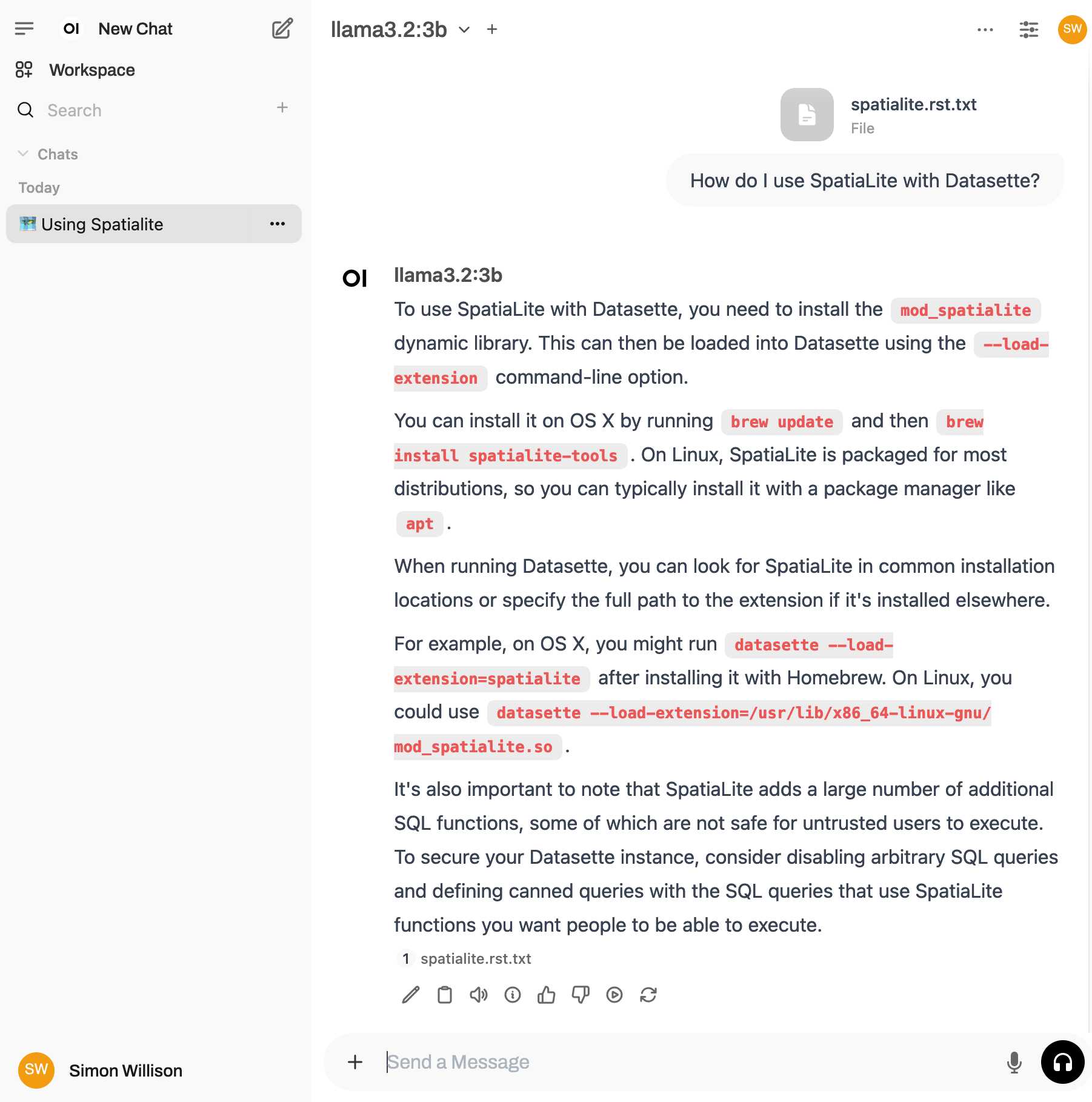
That's honestly a very solid answer, especially considering the Llama 3.2 3B model from Ollama is just a 1.9GB file! It's impressive how well that model can handle basic Q&A and summarization against text provided to it - it somehow has a 128,000 token context size.
Open WebUI has a lot of other tricks up its sleeve: it can talk to API models such as OpenAI directly, has optional integrations with web search and custom tools and logs every interaction to a SQLite database. It also comes with extensive documentation.
I can now run a GPT-4 class model on my laptop
Meta’s new Llama 3.3 70B is a genuinely GPT-4 class Large Language Model that runs on my laptop.
[... 2,905 words]Meta AI release Llama 3.3. This new Llama-3.3-70B-Instruct model from Meta AI makes some bold claims:
This model delivers similar performance to Llama 3.1 405B with cost effective inference that’s feasible to run locally on common developer workstations.
I have 64GB of RAM in my M2 MacBook Pro, so I'm looking forward to trying a slightly quantized GGUF of this model to see if I can run it while still leaving some memory free for other applications.
Update: Ollama have a 43GB GGUF available now. And here's an MLX 8bit version and other MLX quantizations.
Llama 3.3 has 70B parameters, a 128,000 token context length and was trained to support English, German, French, Italian, Portuguese, Hindi, Spanish, and Thai.
The model card says that the training data was "A new mix of publicly available online data" - 15 trillion tokens with a December 2023 cut-off.
They used "39.3M GPU hours of computation on H100-80GB (TDP of 700W) type hardware" which they calculate as 11,390 tons CO2eq. I believe that's equivalent to around 20 fully loaded passenger flights from New York to London (at ~550 tons per flight).
SmolVLM—small yet mighty Vision Language Model. I've been having fun playing with this new vision model from the Hugging Face team behind SmolLM. They describe it as:
[...] a 2B VLM, SOTA for its memory footprint. SmolVLM is small, fast, memory-efficient, and fully open-source. All model checkpoints, VLM datasets, training recipes and tools are released under the Apache 2.0 license.
I've tried it in a few flavours but my favourite so far is the mlx-vlm approach, via mlx-vlm author Prince Canuma. Here's the uv recipe I'm using to run it:
uv run \
--with mlx-vlm \
--with torch \
python -m mlx_vlm.generate \
--model mlx-community/SmolVLM-Instruct-bf16 \
--max-tokens 500 \
--temp 0.5 \
--prompt "Describe this image in detail" \
--image IMG_4414.JPG
If you run into an error using Python 3.13 (torch compatibility) try uv run --python 3.11 instead.
This one-liner installs the necessary dependencies, downloads the model (about 4.2GB, saved to ~/.cache/huggingface/hub/models--mlx-community--SmolVLM-Instruct-bf16) and executes the prompt and displays the result.
I ran that against this Pelican photo:
The model replied:
In the foreground of this photograph, a pelican is perched on a pile of rocks. The pelican’s wings are spread out, and its beak is open. There is a small bird standing on the rocks in front of the pelican. The bird has its head cocked to one side, and it seems to be looking at the pelican. To the left of the pelican is another bird, and behind the pelican are some other birds. The rocks in the background of the image are gray, and they are covered with a variety of textures. The rocks in the background appear to be wet from either rain or sea spray.
There are a few spatial mistakes in that description but the vibes are generally in the right direction.
On my 64GB M2 MacBook pro it read the prompt at 7.831 tokens/second and generated that response at an impressive 74.765 tokens/second.
QwQ: Reflect Deeply on the Boundaries of the Unknown. Brand new openly licensed (Apache 2) model from Alibaba Cloud's Qwen team, this time clearly inspired by OpenAI's work on reasoning in o1.
I love the flowery language they use to introduce the new model:
Through deep exploration and countless trials, we discovered something profound: when given time to ponder, to question, and to reflect, the model’s understanding of mathematics and programming blossoms like a flower opening to the sun. Just as a student grows wiser by carefully examining their work and learning from mistakes, our model achieves deeper insight through patient, thoughtful analysis.
It's already available through Ollama as a 20GB download. I initially ran it like this:
ollama run qwq
This downloaded the model and started an interactive chat session. I tried the classic "how many rs in strawberry?" and got this lengthy but correct answer, which concluded:
Wait, but maybe I miscounted. Let's list them: 1. s 2. t 3. r 4. a 5. w 6. b 7. e 8. r 9. r 10. y Yes, definitely three "r"s. So, the word "strawberry" contains three "r"s.
Then I switched to using LLM and the llm-ollama plugin. I tried prompting it for Python that imports CSV into SQLite:
Write a Python function import_csv(conn, url, table_name) which acceopts a connection to a SQLite databse and a URL to a CSV file and the name of a table - it then creates that table with the right columns and imports the CSV data from that URL
It thought through the different steps in detail and produced some decent looking code.
Finally, I tried this:
llm -m qwq 'Generate an SVG of a pelican riding a bicycle'
For some reason it answered in Simplified Chinese. It opened with this:
生成一个SVG图像,内容是一只鹈鹕骑着一辆自行车。这听起来挺有趣的!我需要先了解一下什么是SVG,以及如何创建这样的图像。
Which translates (using Google Translate) to:
Generate an SVG image of a pelican riding a bicycle. This sounds interesting! I need to first understand what SVG is and how to create an image like this.
It then produced a lengthy essay discussing the many aspects that go into constructing a pelican on a bicycle - full transcript here. After a full 227 seconds of constant output it produced this as the final result.
I think that's pretty good!
Quantization matters (via) What impact does quantization have on the performance of an LLM? been wondering about this for quite a while, now here are numbers from Paul Gauthier.
He ran differently quantized versions of Qwen 2.5 32B Instruct through his Aider code editing benchmark and saw a range of scores.
The original released weights (BF16) scored highest at 71.4%, with Ollama's qwen2.5-coder:32b-instruct-fp16 (a 66GB download) achieving the same score.
The quantized Ollama qwen2.5-coder:32b-instruct-q4_K_M (a 20GB download) saw a massive drop in quality, scoring just 53.4% on the same benchmark.
Ollama: Llama 3.2 Vision. Ollama released version 0.4 last week with support for Meta's first Llama vision model, Llama 3.2.
If you have Ollama installed you can fetch the 11B model (7.9 GB) like this:
ollama pull llama3.2-vision
Or the larger 90B model (55GB download, likely needs ~88GB of RAM) like this:
ollama pull llama3.2-vision:90b
I was delighted to learn that Sukhbinder Singh had already contributed support for LLM attachments to Sergey Alexandrov's llm-ollama plugin, which means the following works once you've pulled the models:
llm install --upgrade llm-ollama
llm -m llama3.2-vision:latest 'describe' \
-a https://static.simonwillison.net/static/2024/pelican.jpg
This image features a brown pelican standing on rocks, facing the camera and positioned to the left of center. The bird's long beak is a light brown color with a darker tip, while its white neck is adorned with gray feathers that continue down to its body. Its legs are also gray.
In the background, out-of-focus boats and water are visible, providing context for the pelican's environment.

That's not a bad description of this image, especially for a 7.9GB model that runs happily on my MacBook Pro.
Qwen2.5-Coder-32B is an LLM that can code well that runs on my Mac
There’s a whole lot of buzz around the new Qwen2.5-Coder Series of open source (Apache 2.0 licensed) LLM releases from Alibaba’s Qwen research team. On first impression it looks like the buzz is well deserved.
[... 697 words]Everything I’ve learned so far about running local LLMs (via) Chris Wellons shares detailed notes on his experience running local LLMs on Windows - though most of these tips apply to other operating systems as well.
This is great, there's a ton of detail here and the root recommendations are very solid: Use llama-server from llama.cpp and try ~8B models first (Chris likes Llama 3.1 8B Instruct at Q4_K_M as a first model), anything over 10B probably won't run well on a CPU so you'll need to consider your available GPU VRAM.
This is neat:
Just for fun, I ported llama.cpp to Windows XP and ran a 360M model on a 2008-era laptop. It was magical to load that old laptop with technology that, at the time it was new, would have been worth billions of dollars.
I need to spend more time with Chris's favourite models, Mistral-Nemo-2407 (12B) and Qwen2.5-14B/72B.
Chris also built illume, a Go CLI tool for interacting with models that looks similar to my own LLM project.
Nous Hermes 3. The Nous Hermes family of fine-tuned models have a solid reputation. Their most recent release came out in August, based on Meta's Llama 3.1:
Our training data aggressively encourages the model to follow the system and instruction prompts exactly and in an adaptive manner. Hermes 3 was created by fine-tuning Llama 3.1 8B, 70B and 405B, and training on a dataset of primarily synthetically generated responses. The model boasts comparable and superior performance to Llama 3.1 while unlocking deeper capabilities in reasoning and creativity.
The model weights are on Hugging Face, including GGUF versions of the 70B and 8B models. Here's how to try the 8B model (a 4.58GB download) using the llm-gguf plugin:
llm install llm-gguf
llm gguf download-model 'https://huggingface.co/NousResearch/Hermes-3-Llama-3.1-8B-GGUF/resolve/main/Hermes-3-Llama-3.1-8B.Q4_K_M.gguf' -a Hermes-3-Llama-3.1-8B
llm -m Hermes-3-Llama-3.1-8B 'hello in spanish'
Nous Research partnered with Lambda Labs to provide inference APIs. It turns out Lambda host quite a few models now, currently providing free inference to users with an API key.
I just released the first alpha of a llm-lambda-labs plugin. You can use that to try the larger 405b model (very hard to run on a consumer device) like this:
llm install llm-lambda-labs
llm keys set lambdalabs
# Paste key here
llm -m lambdalabs/hermes3-405b 'short poem about a pelican with a twist'
Here's the source code for the new plugin, which I based on llm-mistral. The plugin uses httpx-sse to consume the stream of tokens from the API.
SmolLM2 (via) New from Loubna Ben Allal and her research team at Hugging Face:
SmolLM2 is a family of compact language models available in three size: 135M, 360M, and 1.7B parameters. They are capable of solving a wide range of tasks while being lightweight enough to run on-device. [...]
It was trained on 11 trillion tokens using a diverse dataset combination: FineWeb-Edu, DCLM, The Stack, along with new mathematics and coding datasets that we curated and will release soon.
The model weights are released under an Apache 2 license. I've been trying these out using my llm-gguf plugin for LLM and my first impressions are really positive.
Here's a recipe to run a 1.7GB Q8 quantized model from lmstudio-community:
llm install llm-gguf
llm gguf download-model https://huggingface.co/lmstudio-community/SmolLM2-1.7B-Instruct-GGUF/resolve/main/SmolLM2-1.7B-Instruct-Q8_0.gguf -a smol17
llm chat -m smol17
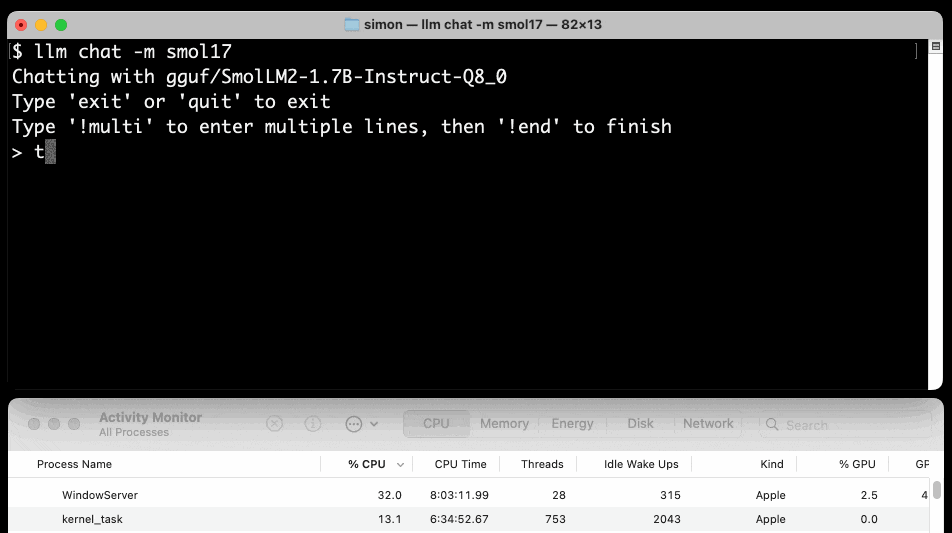
Or at the other end of the scale, here's how to run the 138MB Q8 quantized 135M model:
llm gguf download-model https://huggingface.co/lmstudio-community/SmolLM2-135M-Instruct-GGUF/resolve/main/SmolLM2-135M-Instruct-Q8_0.gguf' -a smol135m
llm chat -m smol135m
The blog entry to accompany SmolLM2 should be coming soon, but in the meantime here's the entry from July introducing the first version: SmolLM - blazingly fast and remarkably powerful .
Running Llama 3.2 Vision and Phi-3.5 Vision on a Mac with mistral.rs
mistral.rs is an LLM inference library written in Rust by Eric Buehler. Today I figured out how to use it to run the Llama 3.2 Vision and Phi-3.5 Vision models on my Mac.
[... 1,231 words]Llama 3.2. In further evidence that AI labs are terrible at naming things, Llama 3.2 is a huge upgrade to the Llama 3 series - they've released their first multi-modal vision models!
Today, we’re releasing Llama 3.2, which includes small and medium-sized vision LLMs (11B and 90B), and lightweight, text-only models (1B and 3B) that fit onto edge and mobile devices, including pre-trained and instruction-tuned versions.
The 1B and 3B text-only models are exciting too, with a 128,000 token context length and optimized for edge devices (Qualcomm and MediaTek hardware get called out specifically).
Meta partnered directly with Ollama to help with distribution, here's the Ollama blog post. They only support the two smaller text-only models at the moment - this command will get the 3B model (2GB):
ollama run llama3.2
And for the 1B model (a 1.3GB download):
ollama run llama3.2:1b
I had to first upgrade my Ollama by clicking on the icon in my macOS task tray and selecting "Restart to update".
The two vision models are coming to Ollama "very soon".
Once you have fetched the Ollama model you can access it from my LLM command-line tool like this:
pipx install llm
llm install llm-ollama
llm chat -m llama3.2:1b
I tried running my djp codebase through that tiny 1B model just now and got a surprisingly good result - by no means comprehensive, but way better than I would ever expect from a model of that size:
files-to-prompt **/*.py -c | llm -m llama3.2:1b --system 'describe this code'
Here's a portion of the output:
The first section defines several test functions using the
@djp.hookimpldecorator from the djp library. These hook implementations allow you to intercept and manipulate Django's behavior.
test_middleware_order: This function checks that the middleware order is correct by comparing theMIDDLEWAREsetting with a predefined list.test_middleware: This function tests various aspects of middleware:- It retrieves the response from the URL
/from-plugin/using theClientobject, which simulates a request to this view.- It checks that certain values are present in the response:
X-DJP-Middleware-AfterX-DJP-MiddlewareX-DJP-Middleware-Before[...]
I found the GGUF file that had been downloaded by Ollama in my ~/.ollama/models/blobs directory. The following command let me run that model directly in LLM using the llm-gguf plugin:
llm install llm-gguf
llm gguf register-model ~/.ollama/models/blobs/sha256-74701a8c35f6c8d9a4b91f3f3497643001d63e0c7a84e085bed452548fa88d45 -a llama321b
llm chat -m llama321b
Meta themselves claim impressive performance against other existing models:
Our evaluation suggests that the Llama 3.2 vision models are competitive with leading foundation models, Claude 3 Haiku and GPT4o-mini on image recognition and a range of visual understanding tasks. The 3B model outperforms the Gemma 2 2.6B and Phi 3.5-mini models on tasks such as following instructions, summarization, prompt rewriting, and tool-use, while the 1B is competitive with Gemma.
Here's the Llama 3.2 collection on Hugging Face. You need to accept the new Llama 3.2 Community License Agreement there in order to download those models.
You can try the four new models out via the Chatbot Arena - navigate to "Direct Chat" there and select them from the dropdown menu. You can upload images directly to the chat there to try out the vision features.
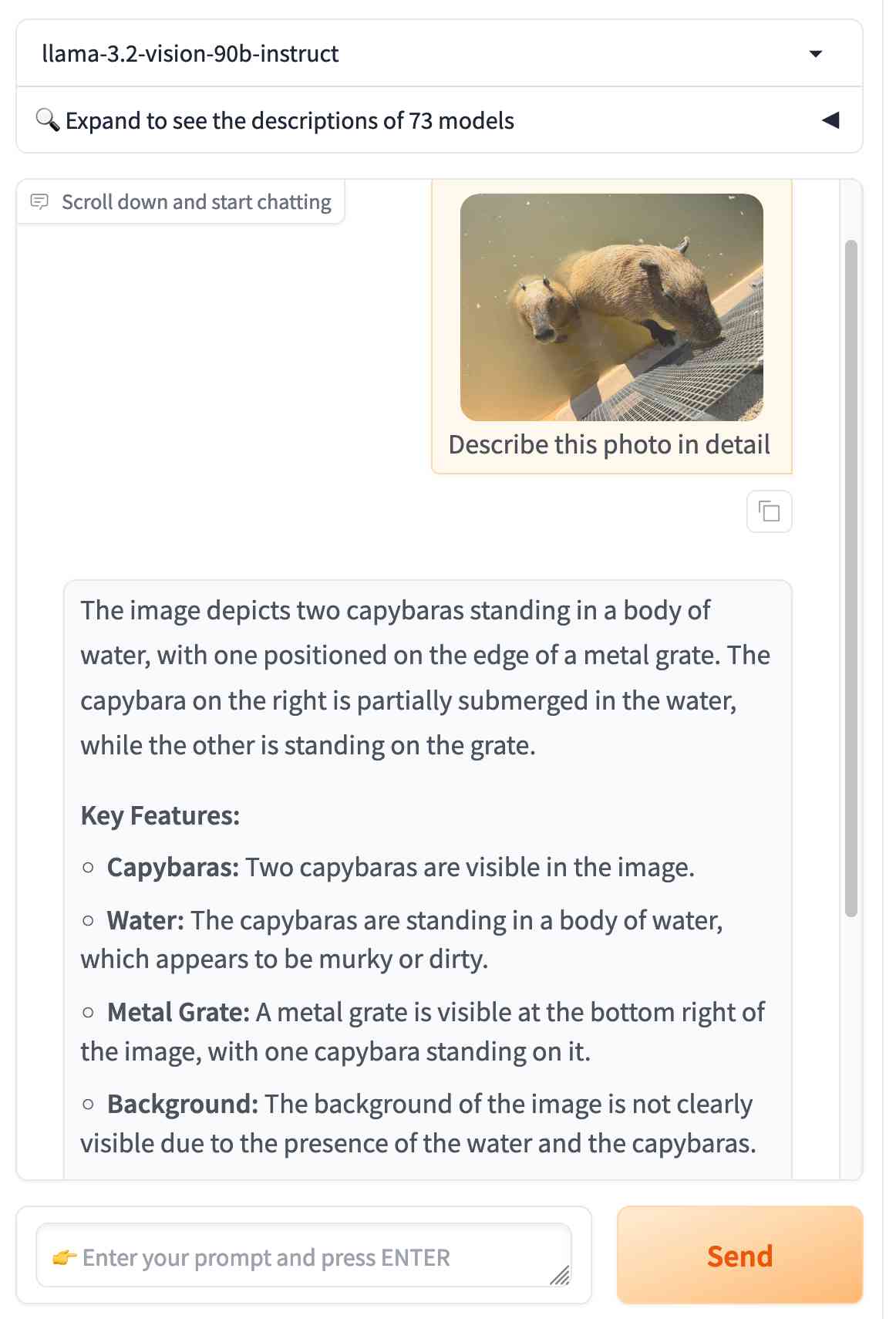
Mistral Large 2 (via) The second release of a GPT-4 class open weights model in two days, after yesterday's Llama 3.1 405B.
The weights for this one are under Mistral's Research License, which "allows usage and modification for research and non-commercial usages" - so not as open as Llama 3.1. You can use it commercially via the Mistral paid API.
Mistral Large 2 is 123 billion parameters, "designed for single-node inference" (on a very expensive single-node!) and has a 128,000 token context window, the same size as Llama 3.1.
Notably, according to Mistral's own benchmarks it out-performs the much larger Llama 3.1 405B on their code and math benchmarks. They trained on a lot of code:
Following our experience with Codestral 22B and Codestral Mamba, we trained Mistral Large 2 on a very large proportion of code. Mistral Large 2 vastly outperforms the previous Mistral Large, and performs on par with leading models such as GPT-4o, Claude 3 Opus, and Llama 3 405B.
They also invested effort in tool usage, multilingual support (across English, French, German, Spanish, Italian, Portuguese, Dutch, Russian, Chinese, Japanese, Korean, Arabic, and Hindi) and reducing hallucinations:
One of the key focus areas during training was to minimize the model’s tendency to “hallucinate” or generate plausible-sounding but factually incorrect or irrelevant information. This was achieved by fine-tuning the model to be more cautious and discerning in its responses, ensuring that it provides reliable and accurate outputs.
Additionally, the new Mistral Large 2 is trained to acknowledge when it cannot find solutions or does not have sufficient information to provide a confident answer.
I went to update my llm-mistral plugin for LLM to support the new model and found that I didn't need to - that plugin already uses llm -m mistral-large to access the mistral-large-latest endpoint, and Mistral have updated that to point to the latest version of their Large model.
Ollama now have mistral-large quantized to 4 bit as a 69GB download.
gemma-2-27b-it-llamafile (via) Justine Tunney shipped llamafile packages of Google's new openly licensed (though definitely not open source) Gemma 2 27b model this morning.
I downloaded the gemma-2-27b-it.Q5_1.llamafile version (20.5GB) to my Mac, ran chmod 755 gemma-2-27b-it.Q5_1.llamafile and then ./gemma-2-27b-it.Q5_1.llamafile and now I'm trying it out through the llama.cpp default web UI in my browser. It works great.
It's a very capable model - currently sitting at position 12 on the LMSYS Arena making it the highest ranked open weights model - one position ahead of Llama-3-70b-Instruct and within striking distance of the GPT-4 class models.
Ultravox (via) Ultravox is "a multimodal Speech LLM built around a pretrained Whisper and Llama 3 backbone". It's effectively an openly licensed version of half of the GPT-4o model OpenAI demoed (but did not fully release) a few weeks ago: Ultravox is multimodal for audio input, but still relies on a separate text-to-speech engine for audio output.
You can try it out directly in your browser through this page on AI.TOWN - hit the "Call" button to start an in-browser voice conversation with the model.
I found the demo extremely impressive - really low latency and it was fun and engaging to talk to. Try saying "pretend to be a wise and sarcastic old fox" to kick it into a different personality.
The GitHub repo includes code for both training and inference, and the full model is available from Hugging Face - about 30GB of .safetensors files.
Ultravox says it's licensed under MIT, but I would expect it to also have to inherit aspects of the Llama 3 license since it uses that as a base model.
PaliGemma model README (via) One of the more over-looked announcements from Google I/O yesterday was PaliGemma, an openly licensed VLM (Vision Language Model) in the Gemma family of models.
The model accepts an image and a text prompt. It outputs text, but that text can include special tokens representing regions on the image. This means it can return both bounding boxes and fuzzier segment outlines of detected objects, behavior that can be triggered using a prompt such as "segment puffins".
You can try it out on Hugging Face.
It's a 3B model, making it feasible to run on consumer hardware.
experimental-phi3-webgpu (via) Run Microsoft’s excellent Phi-3 model directly in your browser, using WebGPU so didn’t work in Firefox for me, just in Chrome.
It fetches around 2.1GB of data into the browser cache on first run, but then gave me decent quality responses to my prompts running at an impressive 21 tokens a second (M2, 64GB).
I think Phi-3 is the highest quality model of this size, so it’s a really good fit for running in a browser like this.
microsoft/Phi-3-mini-4k-instruct-gguf (via) Microsoft’s Phi-3 LLM is out and it’s really impressive. This 4,000 token context GGUF model is just a 2.2GB (for the Q4 version) and ran on my Mac using the llamafile option described in the README. I could then run prompts through it using the llm-llamafile plugin.
The vibes are good! Initial test prompts I’ve tried feel similar to much larger 7B models, despite using just a few GBs of RAM. Tokens are returned fast too—it feels like the fastest model I’ve tried yet.
And it’s MIT licensed.
We introduce phi-3-mini, a 3.8 billion parameter language model trained on 3.3 trillion tokens, whose overall performance, as measured by both academic benchmarks and internal testing, rivals that of models such as Mixtral 8x7B and GPT-3.5 (e.g., phi-3-mini achieves 69% on MMLU and 8.38 on MT-bench), despite being small enough to be deployed on a phone.
Options for accessing Llama 3 from the terminal using LLM
Llama 3 was released on Thursday. Early indications are that it’s now the best available openly licensed model—Llama 3 70b Instruct has taken joint 5th place on the LMSYS arena leaderboard, behind only Claude 3 Opus and some GPT-4s and sharing 5th place with Gemini Pro and Claude 3 Sonnet. But unlike those other models Llama 3 70b is weights available and can even be run on a (high end) laptop!
[... 1,962 words]llm-gpt4all. New release of my LLM plugin which builds on Nomic's excellent gpt4all Python library. I've upgraded to their latest version which adds support for Llama 3 8B Instruct, so after a 4.4GB model download this works:
llm -m Meta-Llama-3-8B-Instruct "say hi in Spanish"
Mistral tweet a magnet link for mixtral-8x22b. Another open model release from Mistral using their now standard operating procedure of tweeting out a raw torrent link.
This one is an 8x22B Mixture of Experts model. Their previous most powerful openly licensed release was Mixtral 8x7B, so this one is a whole lot bigger (a 281GB download)—and apparently has a 65,536 context length, at least according to initial rumors on Twitter.
Gemma: Introducing new state-of-the-art open models. Google get in on the openly licensed LLM game: Gemma comes in two sizes, 2B and 7B, trained on 2 trillion and 6 trillion tokens respectively. The terms of use “permit responsible commercial usage”. In the benchmarks it appears to compare favorably to Mistral and Llama 2.
Something that caught my eye in the terms: “Google may update Gemma from time to time, and you must make reasonable efforts to use the latest version of Gemma.”
One of the biggest benefits of running your own model is that it can protect you from model updates that break your carefully tested prompts, so I’m not thrilled by that particular clause.
UPDATE: It turns out that clause isn’t uncommon—the phrase “You shall undertake reasonable efforts to use the latest version of the Model” is present in both the Stable Diffusion and BigScience Open RAIL-M licenses.
2023
The AI trust crisis
Dropbox added some new AI features. In the past couple of days these have attracted a firestorm of criticism. Benj Edwards rounds it up in Dropbox spooks users with new AI features that send data to OpenAI when used.
[... 1,733 words]Build an image search engine with llm-clip, chat with models with llm chat
LLM is my combination CLI tool and Python library for working with Large Language Models. I just released LLM 0.10 with two significant new features: embedding support for binary files and the llm chat command.
Running my own LLM (via) Nelson Minar describes running LLMs on his own computer using my LLM tool and llm-gpt4all plugin, plus some notes on trying out some of the other plugins.
Run Llama 2 on your own Mac using LLM and Homebrew
Llama 2 is the latest commercially usable openly licensed Large Language Model, released by Meta AI a few weeks ago. I just released a new plugin for my LLM utility that adds support for Llama 2 and many other llama-cpp compatible models.
[... 1,423 words]Llama 2: The New Open LLM SOTA. I’m in this Latent Space podcast, recorded yesterday, talking about the Llama 2 release.
llama2-mac-gpu.sh (via) Adrien Brault provided this recipe for compiling llama.cpp on macOS with GPU support enabled (“LLAMA_METAL=1 make”) and then downloading and running a GGML build of Llama 2 13B.



